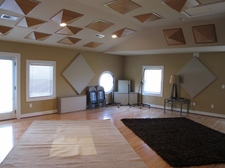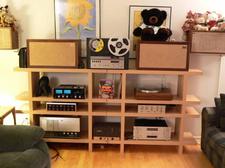It’s the time of year for saving money!
Probably one of the first articles ever written for consumers (not hobbyists) about a home sound reproduction system was about how to budget or allocate money for it. Over the years recommendations have changed. I remember in the distant past there was the 1/3 rule – 1/3 for the speakers, 1/3 for the amp and 1/3 for the front end. Then I remember seeing the 50/50 rule – that one was ½ for the speakers and ½ for everything else. That one is still used by many salesmen and enthusiasts.
 Thinking about the 50/50 rule I wondered how I would divide up a $10k budget for a home audio system. But before I can start slicing up the pot into categories we need to determine what is actually needed today for a home sound system. And before we can figure out what is needed we need to find out what the end-user wants the system to do, and if their goals are within the realm of possibility or their budget.
Thinking about the 50/50 rule I wondered how I would divide up a $10k budget for a home audio system. But before I can start slicing up the pot into categories we need to determine what is actually needed today for a home sound system. And before we can figure out what is needed we need to find out what the end-user wants the system to do, and if their goals are within the realm of possibility or their budget.
Obviously we need some transducers, either speakers or headphones to make sound. But whether the transducers are going to be headphones or loudspeakers will have an effect on how we allocate the rest of the funds. Also what kind of speakers and where they can be located will be an important decision. For the sake of this article’s length I’m going to narrow the parameters – Lets say we are putting together a “traditional” stereo system with two main speakers for a room-based system. For this kind of audio system I would allocate funds as follows: $3k for loudspeakers, $3k for electronics (both preamplifier and power amplifier), $1k for cabling and connecting wire, $1k for room treatments, and $2k for source devices (to be divided between turntables, CD sources, DACs, or streamers).
 And why did I divide up my $10k grubstake as I did? Because it made sense, and within this allocation you could come up with a wide variety of applicable products and still be on budget. Probably the most radical departure in my budget from the more traditional divisions is that I allocate specific amounts for both cabling and room treatments, both of which usually receive less attention in a beginning or new system.
And why did I divide up my $10k grubstake as I did? Because it made sense, and within this allocation you could come up with a wide variety of applicable products and still be on budget. Probably the most radical departure in my budget from the more traditional divisions is that I allocate specific amounts for both cabling and room treatments, both of which usually receive less attention in a beginning or new system.
Of course this budget could be tweaked in various ways. You could put more money into loudspeakers and less into electronics or you could eliminate room treatments and slide that money into the electronics or cables budget (but I wouldn’t recommend it). You could also budget for growth – buy a less-expensive component in a category that you know you will want to upgrade in a few years and put the money left over into a higher-priced component that you intend to keep longer-term. Also you could slice the budget in half – then you would have $1.5k for loudspeakers, $1.5k for electronics, $500 for cabling, $500 for room treatments, and $1000 for source components.
 And how would I divide up $10k for a desktop computer-based system? After looking at my current set-up I thought, “Sure, that works.” The divison was as follows – monitor speakers $2.5k, Subwoofer $1.5k, DAC/Pre $2K, Power amplifier $2k, cables $1k, room treatments $1k. For a $5000 budget I’d use $1.25k for speakers, $750 for a subwoofer, $1k for DAC/pre, $1k for power amplifier, $500 for cables, and $500 for room treatments. The front end would be the computer you already have.
And how would I divide up $10k for a desktop computer-based system? After looking at my current set-up I thought, “Sure, that works.” The divison was as follows – monitor speakers $2.5k, Subwoofer $1.5k, DAC/Pre $2K, Power amplifier $2k, cables $1k, room treatments $1k. For a $5000 budget I’d use $1.25k for speakers, $750 for a subwoofer, $1k for DAC/pre, $1k for power amplifier, $500 for cables, and $500 for room treatments. The front end would be the computer you already have.
As with all budget suggestions, my method is only a rough outline, but it does give a beginning audiophile somewhere to start their journey. And of, course, you can always spend more, or less…








